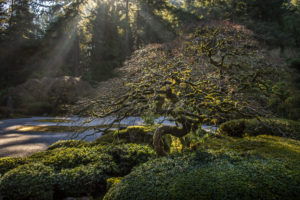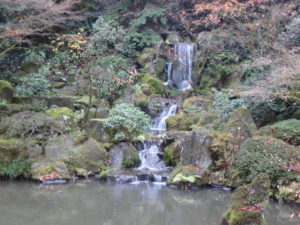The Japanese Garden of Portland, Oregon
Visiting a garden in winter allows me to see the bones of a garden, the internal structure which supports and enhances the flowers and leaves of the other three seasons. I like to go slowly through a winter garden to allow the spirit and essence of the garden to sink in. I recently visited the Japanese Garden of Portland, Oregon on a sunny, cold day. I left feeling calm and rejuvenated.
There are three main elements of a Japanese Garden. The first is stone, which provides a link to the mountains of Japan and provides a feeling of stability. The second is water, the life-giving force. For me, running water provides the music of a garden, which encourages tranquility. Quiet pools reflect sky and trees. Lastly, the plants of the garden provide the color and patterns that make each garden special. And of course, the trees in winter provide bones for the garden, along with the stone.
The Japanese Garden of Portland was conceived in 1961 as a way to promote cross-cultural understanding; it was first open to the public in 1967. It is one of the best examples of a Japanese garden outside of Japan, and is fully mature now, more than 50 years after the first plantings.
Of those original plantings, some of the most impressive are the Japanese red maples (Acer palmatum). These trees are planted throughout the garden, and many have been pruned to encourage lateral growth and are often in an umbrella shape.
Now is the best time to see those maples if you want to see their form, though the leaves are wonderful in spring, summer and fall. There are many with finely cut leaves in the garden, the ‘dissectum’ varieties. Unfortunately for me, the dissectum varieties are generally less hardy; many just to zone 6 (minus 10 degrees F in winter). The standard Japanese red maple is good to Zone 4 (minus 25 or 30), and the variety ‘Bloodgood’ is the hardiest of all. I have two, and I think every garden should have at least one.
Other trees at the Japanese Garden include Japanese red pine, Japanese black pine, azalea, rhododendron, ginkgo and various large firs, cedars and hemlock. There is an advantage to having evergreens in the garden, as they provide color – green – all winter.
There are two stone or gravel gardens in the Japanese Garden of Portland. In each of these there is a “sea” of gravel. That gravel is raked to create parallel ridges around the stones, mimicking waves in the sea. One has several large stones, representing mountains – but little else. In the main stone garden near the tea house there are also moss-covered islands and peninsulas in the gravel sea. I was told that the gravel in the bigger stone garden space was shipped from Japan.Stone lanterns are commonly placed on peninsulas in Japanese gravel gardens serving as lighthouses.
The Japanese Garden of Portland has streams, ponds and pools, all important elements for a Japanese garden. There is a wonderful hillside with a waterfall and a stream that feeds a pond. In the pond are koi; these resemble goldfish and can get to be quite large. Some are orange, others white, some spotted. Koi are the Labrador retrievers of the water: good looking and always looking for a handout.
I called senior gardener Adam Hart after I returned to New Hampshire to ask about flowers that bloom in the gardens in the warmer seasons. I was surprised that the gardens really do not have herbaceous perennials as part of the plant palette, with the exception of Japanese iris (Iris ensata).
Mr. Hart explained that although some of the trees bloom with colorful flowers, the plants installed should generally have 4 season interest – hence no primroses, peonies or other Japanese flowers. Just the iris, which are similar to our bearded iris, but the falls (outer petals) lie flat out, horizontally. The blossoms can be quite large, up to 6 inches across. I grow them, they are hardy to Zone 4,minus 30 in winter. They like wet soils, and will even grow in standing water. Fabulous plants. The iris are in bloom in June and July, so that would be an excellent time to visit.
For me, it is important that a Japanese garden is sparse, simple, and quiet. It should encourage a person to be reflective and have seating so one can relax and enjoy what the garden has to offer. It should have open spaces and lots of stone and gravel.
The Japanese Garden of Portland is open all year, so if you plan to go to Portland, schedule a visit. There is a discount for tickets purchased in advance, and for seniors or children. Visit the website, https://japanesegarden.org for more information.
Henry’s web site is www.Gardening-Guy.com. He is the author of 4 gardening books. You may reach him at henry.homeyer@comcast.net.





